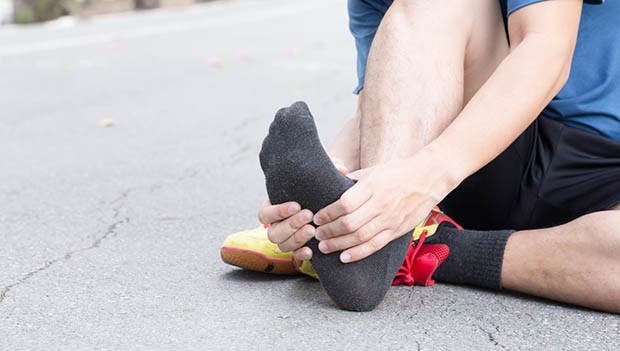
Plantar fasciitis (or fasciosis) remains one of the most common foot injuries that dashes the training and racing hopes of many runners. Tell-tale signs of the condition include sharp pain in the heel when getting out of bed in the morning, and again when standing or walking after sitting for long periods. The tricky thing about plantar fasciitis/fasciosis is that many athletes can continue to run with symptoms—the condition has to be pretty severe to make a stubborn runner with a high pain threshold stop training. Even trickier: If a runner uses the right tools to treat plantar fasciitis/fasciosis, and commits to strengthening and stretching the affected area, he or she can continue to run at a low to moderate level until symptoms improve. Find out how to be that runner.
What Is Plantar Fasciitis and What Causes It?
Plantar fasciitis is becoming known as "plantar fasciosis" among the sports medicine community, and new evidence challenges the previous idea that plantar fasciitis is caused by inflammation of the plantar fascia. A study published in 2003 in The Journal of American Podiatric Medical Association failed to show evidence of inflammation in tissue samples taken from patients diagnosed with plantar fasciitis. An article published in Podiatry Today supports this evidence, claiming that plantar fasciitis is not inflammatory, but rather degenerative—meaning it causes the death of plantar fascia tissue.
The most common symptoms of plantar fasciosis include: heel pain that happens when taking your first steps out of bed in the morning, and heel pain that occurs when standing or walking after a long period of sitting.
MORE: How to Prevent Foot Pain
5 Beneficial Barefoot Exercises for Plantar Fasciitis
While ice, rest, orthotics and pain relievers may ease the discomfort, the injury can come back again (and again) unless you address the underlying cause—weak and tight muscles and tendons that make up and support the foot, says Irene Davis, Ph.D., P.T., director of the Spaulding National Running Center, Harvard Medical School in Cambridge, Massachusetts.
If arch pain is your nemesis, Davis recommends doing these five daily exercises barefoot.
How to Run Safely With Plantar Fasciitis
When Ella Johnson of Jacksonville, Florida, was sidelined with plantar fasciitis three years ago, she ran in the pool six days per week for eight months. "It was a way for me to still enjoy my favorite sport even though I was injured," Johnson says. "When I was ready to hit the roads again, my 5K times were comparable to what they had been before...even though I hadn't actually 'run' in months!"
Can Botox Cure Plantar Fasciitis?
If you've had heel pain for more than three months, tried other therapies with no success, and are willing to pony up for relief, ask your doctor about these innovative procedures: extracorporeal shock wave therapy, platelet-rich plasma, botox, dry needling.


